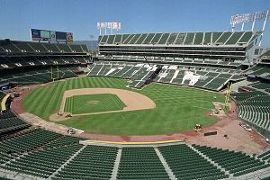|
OAKLAND, Calif. -- A small army of worker bees has already mobilized in the East Bay. And the moment the final out of the American League Division Series Game 2 between the Oakland Athletics and Detroit Tigers is recorded Saturday night, that army will spring into action. The goal? To transform O.co Coliseum from an MLB field into an NFL-ready locale. The workers, about 200 of them, have no option in the timing. The Oakland Raiders' game Sunday night against the San Diego Chargers -- with kickoff moved to 11:35 p.m. ET from the originally scheduled 4:25 p.m. ET start because of the Tigers-A's game -- demands it. The transformation of the lone remaining dual MLB-NFL complex in the United States should take 18 to 20 hours, plus safety inspections, and costs more than $250,000 each time.  “My understanding,” A’s vice president of stadium operations David Rinetti said, “is that it’s all-hands-on-deck to make this happen. Because it’s overnight, it hasn’t been done like this before, where it’s gone from baseball to football in such a quick amount of time. “My understanding,” A’s vice president of stadium operations David Rinetti said, “is that it’s all-hands-on-deck to make this happen. Because it’s overnight, it hasn’t been done like this before, where it’s gone from baseball to football in such a quick amount of time.
“Typically, it’s a couple-of-days process.” Usually, when it’s a 24-hour flip, the crew is going from football to baseball, from a Sunday afternoon Raiders game to a Monday evening A’s game. That was the case the night of Sept. 15, when the Coliseum was transformed after the Raiders beat the Jacksonville Jaguars and the A’s were to play host to the Los Angeles Angels. This flip, involving a baseball playoff game and what has become a nationally televised football game for night owls coast-to-coast, is different. According to Rinetti, the breakdown will begin with outfield fence pads and fence posts coming out as the 17 sections of visitor sideline seats -- totaling about 6,000 seats that reside out in the "B" parking lot during baseball games -- are loaded onto massive carts on wheels. What looks like “tons” of plywood are put down in what is center field in the baseball configuration, along with “huge” railroad ties to help two cranes maneuver about. It all comes down a ramp in center field, and the football stands begin to take shape. “The cranes can only go as fast as the cranes go, it doesn’t matter how many people are here [to work]," Rinetti said. “There’s two cranes, and they have to do what they have to do.” Meanwhile, there will be countless workers roaming the stadium, cleaning up trash from a baseball crowd expected to be near 48,000 (the A’s removed the tarps from the upper deck of the original bowl, but left the top of Mt. Davis covered) and removing non-essential signage. “It needs to be done by 2 in the afternoon the next day,” Rinetti said. If it were just about converting the playing surface, that would be no sweat for head groundskeeper Clay Wood and his eight-man crew. Though it’s harder for the stadium to go from baseball to football, it’s actually easier for the playing surface to go that route, because there are fewer tedious things to do and less precision needed to do them. “The field’s already going to be in good football shape,” said Wood, in his 19th season as the head groundskeeper. “The hard thing is after football games, the field’s not in good baseball shape, especially the infield dirt. Unfortunately that’s right down the middle of the field, which is unfortunate for both the Raiders and the A’s. But we have to make sure when we come back for baseball, the ball has to roll on there, it has to bounce on there true. That has to be perfect. “The divots and stuff in the outfield, we have to make sure we fill them all in so that’s true and the ball will roll fast. We’ve already done all that work.” For football, beside dealing with an “antiquated” bleacher system that been around since 1996 and crushes the outfield grass, it’s a matter of removing the pitching mound from what will be the 50-yard line on the Raiders' sideline, and the two bullpen mounds, which are in either end zone. Sod fills those spaces. Then there’s the matter of repainting the yard lines and hashmarks -- they were painted with 30 gallons of green dye to minimize their appearance on a baseball field -- and packing down the infield dirt just right. It cannot be too soft, lest the white paint of the yard lines be lost in a cloud of dust on a tackle. And it cannot be too rigid, for obvious player-safety reasons. “I’ll start painting a lot sooner than I normally would,” said Wood, who uses 35 to 40 gallons of white paint for a football field. “So we’ll be going for it as soon as the baseball game is over. “There’s definitely going to be a lot of bodies all over doing a lot of different things.” A potential wrinkle? What if the A’s and Tigers go extra innings? The A’s did, after all, go 19 innings in a game against the Angels in April, and needed 18 innings to beat the New York Yankees in a June game. But there was no football game the next day for which to prepare. “Again,” Wood said. “It’s just the situation we’re in.” No wonder he has already checked out the A’s schedule for September 2014 ... just in case. For now, though, the Raiders do not have another home game until Oct. 27. And if the A’s are in the World Series, they would play Game 2 at the Coliseum on Oct. 24 and, if needed, Game 6 on Oct. 30.
|
